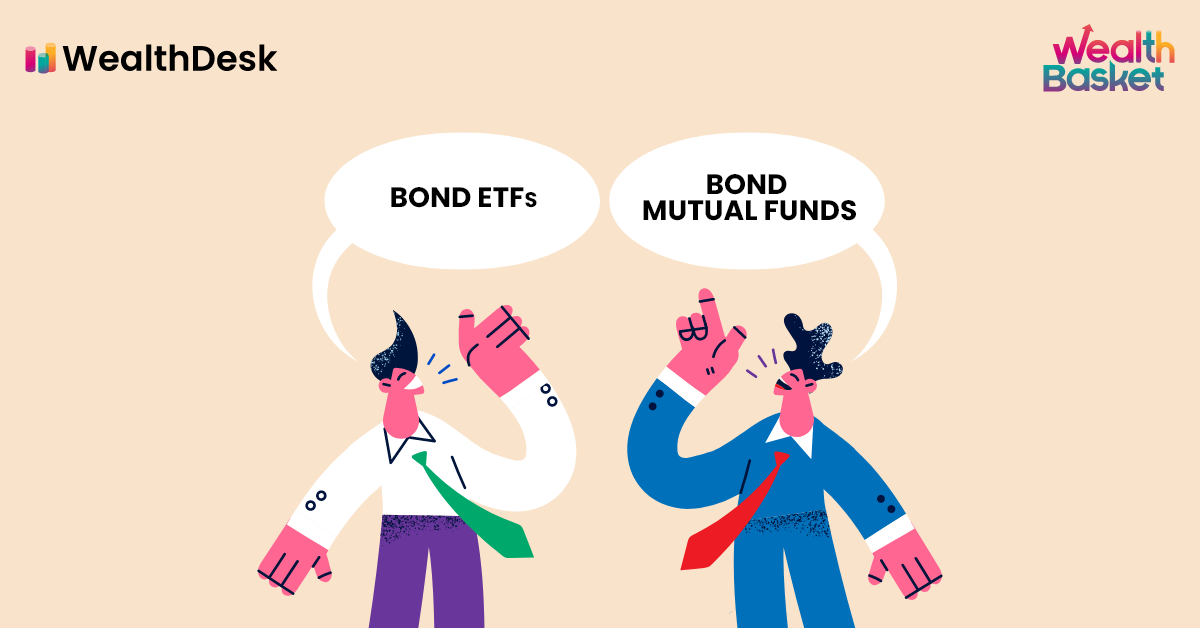The prediction of Mr. Gurpreet Chhatwal, the president of Crisil, during the launch of India’s first PSU corporate bond ETF – Bharat Bond ETF is,
“Bond ETFs have the potential to emerge as an alternate investment avenue for retail investors, considering their ease of use, low cost, and liquidity. They can also help showcase the attractiveness of fixed-income investing and can be used as a stepping stone to more actively managed debt funds.”
Although India is not currently included in global fixed income benchmarks, the introduction of India’s Sovereign Bond ETF on the Amsterdam stock exchange could be a watershed moment to recognize the country’s bond market.
But, how promising does the bond ETF market look? Should you invest in the bond ETFs in India?
This blog explains all you need to know about the bond ETFs, from their meaning, types, how they work, and the pros and cons of investing in them.
What Is a Bond ETF?
Bond exchange-traded funds (ETFs) only invest in bonds and duplicate their price performance on the index. Bond ETFs, also called debt ETFs, are specific financial vehicles that expose investors to fixed-income assets.
These debt ETFs trade on the stock exchange and can be purchased and sold at actual market values like stock ETFs. Since they track a particular index, they are called passively managed instruments.
How Bond ETFs Work?
Bond ETFs are passive funds, but they have the added benefit of liquidity and low cost. Unlike typical open-ended bond mutual funds, these funds trade on the exchange at a far lower price than actively managed funds throughout the day.
Bond ETFs, like stock ETFs, closely mirror the index and allow investors to purchase and sell while investing in fixed income assets.
For example, Bharat bond ETF invests only in the debt of the ‘AAA’-rated public sector companies that track the Nifty Bharat Bond Index – April 2032.
Who Should Invest in Bond ETFs?
Investors who follow the asset allocation theory must invest in bond ETFs as they can provide stability and consistent income during weak markets and income during economic ups and downs, such as during economic downturns.
If you want to earn an income from your investments, investing a significant sum in bond ETFs may work. You may benefit when the bond you are exposed to matures.
Bonds ETFs are an investment option for people who cannot or do not want to deal with the stock market’s volatility. While equities have outperformed bonds in the long run, some investors are unwilling to accept the downside risk of the stock market when it falls.
Discover stocks that suit certain filter criteria and dive into details to check their WealthBaskets.
Types of Bond ETFs
There are various Bond ETFs on the market today, and choosing the appropriate one might be difficult. It is preferable to categorize them to gain explicit knowledge and make an informed decision.
In India, so far, we only have two types of bond ETFs – Sovereign Bond ETF and Corporate Bond ETF.
Sovereign Bond ETF
UTI India Sovereign Bond ETF issued by the central government of India tracks the Nifty India Select 7 Government Bond Index, including the top seven most-liquid, local currency sovereign bonds.
The index methodology is developed explicitly for global investors, having advantageous features such as high secondary market liquidity and considerable unutilized limitations for Foreign Portfolio Investors (FPIs).
Corporate Bond ETF
ETFs that invest in corporate bonds invest in debt issued by companies having investment-grade credit ratings. Bonds in these funds can have varying maturities and firms from various industries.
The first corporate bond ETF, the Bharat Bond ETF in India, was launched by Edelweiss Asset Management Company. Its target capitalization at the time of launch was ₹15,000 crore and aimed to invest in AAA-rated bonds issued by public sector enterprises.
Is Investing in Bond ETF a Good Idea?
Bond ETFs are gaining popularity among investors seeking more debt exposure in their portfolios. Some of the best bond ETFs for long-term investing provides simplicity and openness that is not achievable when investing directly in global bond markets.
Here are three compelling reasons to include fixed-income ETFs in your portfolio.
Flexible Trading
While bonds may have a lock-in period, or you may have to hold them until maturity, the bond ETFs are pretty flexible in trading. You can buy or sell bond ETFs on the stock exchange.
Diversification
Through bond ETFs, you can gain access to a well-diversified fixed income portfolio which may not be so easily accessible with the purchase of bonds separately.
Purchasing such a diverse basket of fixed-income securities directly in the market would undoubtedly necessitate a hefty investment beyond most individuals’ reach. Bond ETFs also make it possible to implement asset allocation decisions swiftly and efficiently.
Liquidity
Bond ETFs offer liquidity to you to give you the freedom to sell your ETFs anytime you want and convert your investment into cash in case of need. It is not the case with the bonds that come with a fixed maturity period.
Risks of Investing in the Bond ETFs
Bond ETFs can be a smart option if you plan and invest with an ETF strategy to diversify your portfolio. Bond ETFs work for long-term, buy-and-hold investors, but it’s best to conduct your research before buying, because of bond ETF risks.
Risk of Loss
Because bond ETFs trade on the stock exchange, they cannot provide the same level of security for your initial investment as individual bonds may. In other words, you may have a loss on your investments as the bond ETFs will be sold at the market price prevailing on the date of sale.
Risk of Rising Interest Rate
Rates of interest fluctuate throughout your investment tenure. When interest rates rise, the value of bonds may fall, and selling such bonds may result in a loss on your initial investment.
Individual bonds decrease the risk of portfolios, by simply holding on to them until maturity when you will receive their total face value. On the other hand, Bond ETFs do not age, so there is little you can do to avoid the sting of rising interest rates.
Market Volatility Risk
Bond ETFs are prone to market risk, and hence, although the bond ETFs track a particular index, the ETF prices may fluctuate due to market fluctuations.
Conclusion
ETFs can offer desirable advantages over acquiring equities directly in less liquid markets. This is true in the recently developed Indian bond ETFs markets, where investors face unique diversification, liquidity, and pricing issues.
At WealthDesk, we offer you a readymade WealthBaskets consisting of stocks or ETFs reflecting an investment strategy or theme designed explicitly by the SEBI-approved investment professionals, and make your investment journey hassle-free.
FAQs
Bond ETFs offer almost all benefits as provided by the bonds, but they also provide flexibility to trade them whenever you want on the stock exchange.
Bond ETFs invest in fixed-income assets, including corporate bonds. Bond ETFs enable ordinary investors to acquire low-cost passive exposure to benchmark bond indices.
An ETF can only be purchased and sold on a stock exchange during market hours. Index funds seek to replicate an underlying index’s performance; however, they do not offer investors intraday buying or selling prices. The funds’ net asset values (NAVs) are published at the end of the day.


















